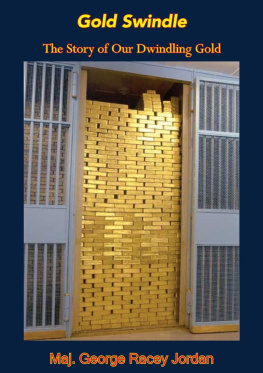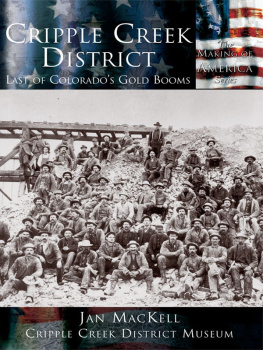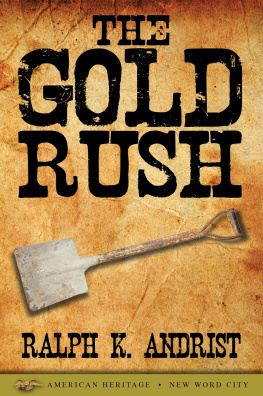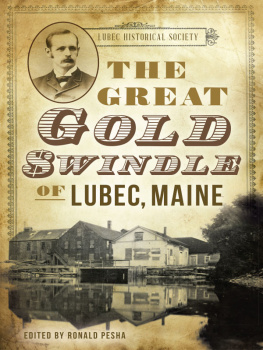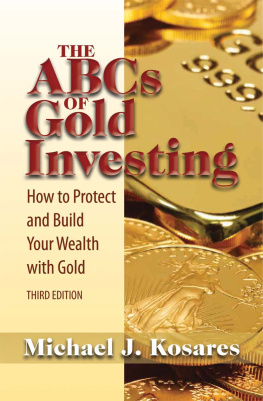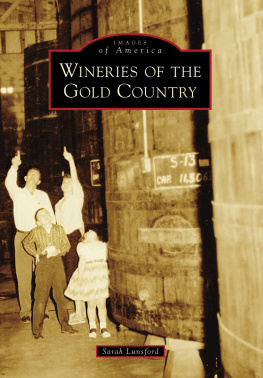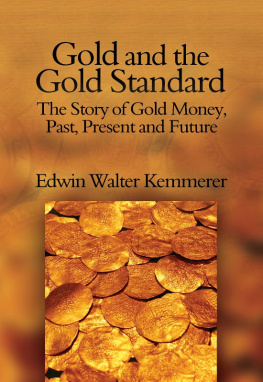This edition is published by Papamoa Press www.pp-publishing.com
To join our mailing list for new titles or for issues with our books papamoapress@gmail.com
Or on Facebook
Text originally published in 1959 under the same title.
Papamoa Press 2018, all rights reserved. No part of this publication may be reproduced, stored in a retrieval system or transmitted by any means, electrical, mechanical or otherwise without the written permission of the copyright holder.
Publishers Note
Although in most cases we have retained the Authors original spelling and grammar to authentically reproduce the work of the Author and the original intent of such material, some additional notes and clarifications have been added for the modern readers benefit.
We have also made every effort to include all maps and illustrations of the original edition the limitations of formatting do not allow of including larger maps, we will upload as many of these maps as possible.
GOLD SWINDLE
THE STORY OF OUR DWINDLING GOLD
BY
GEORGE RACEY JORDAN
MAJOR USAF RET.
ACKNOWLEDGEMENTS
It is appropriate that I acknowledge the efforts of those who have helped me to assemble the data in this book.
Miss Edna Lonigan, the professional writer, sorted and compiled the material from my many speeches and has helped to polish my final script.
Mr. Paul Bakewell, Jr., author of the recent book Inflation in the United States (Caxton Printers, Ltd., Caldwell, Idaho), has furnished part of the legal background. As a consulting attorney in the Laycock vs Kenney case now before the U.S. Court of Appeals for the Ninth District his opinions were studied.
Mr. Harry Sears, who has spear-headed the mine operators fight for the revival of the gold mining industry for many years, rendered valuable assistance.
Finally, I must mention my courageous publisher, Lyle H. Munson, who publishes and distributes books he considers are in the best interests of our country and who joins me in the belief that approval of this Republic, and the free enterprise system, means also that we should fight for it by standing in the path of an insistent design.
George Racey Jordan
September 1959
Part 1. The Gold Threat To National Security
Chapter 1The Gold Hemorrhage
For over twenty-five years our Government has kept its vast hoard of all the monetary gold in the United States buried under the ground at Fort Knox and in other Treasury depositaries. This gold is carefully guarded day and night by every protection that human strength, ingenuity and electronic systems can afford against theft.
Not one of the 400-ounce gold bars in this hoard can be moved without the authorization of the United States Government, nor without massive security precautions being taken during an actual gold transfer.
The American people, whenever they stop to think about it, derive a deep sense of security from the knowledge that this gold backing, or solid base, for our money is safe on American soil, guarded by every device known to our security experts.
Ever since the time the Treasury demanded and secured all gold privately held by individuals or banks, and Congress made private possession of the precious metal a crime (except in the form of newly mined or placer gold), the American people have regarded this buried treasure as a secure protection behind the paper tokens called dollars.
How could any part of this great treasure be lost, when by law the Government of the United States is pledged to preserve it, and every possible kind of protection is placed around it? It would be unthinkable, you will say, to have such doubts about the gold we were forced to give over to our Government to have and to hold.
Nevertheless the gold, most of which is still held physically within this country, is no longer ours legally. Only a fraction of it belongs to our Government. Irrespective of physical removal, it has been lost to us.
In the past ten years we have lost $8,000,000,000 by gold shipments abroad. We are losing today and there is every expectation that this outward flow will continue.
Why has this happened? Because, even though Americans may not exchange their paper money or checks for gold, claimants outside of the United States can demand gold for their paper money or silver if they wish. These claimants include foreign central banks, the depositors and customers of those banks, Americans living or doing business abroad, and international agencies, such as the United Nations, the International Bank, the International Monetary Fund, and other United Nations subsidiaries.
This gold hoard is now in our Governments keeping, but really only under a warehouse keeping agreementbeing stored at taxpayers expense even though ear-marked for international ownership.
No American can own gold in this country or abroad except for use in jewelry-making, dental work, and in certain arts and sciences but any foreign trader, any foreign government receiving American dollars as foreign aid, any international agency receiving grants in dollars from the United States, can turn his dollars into gold on demand. It is a privilege not to be an American citizen.
The current drain upon our gold hoard is due to these foreign claims being cashed in by their owners. Furthermore, these foreign claimants have not as yet taken out all the gold they own. At the end of 1960 they still had the right to withdraw more than $20 billion of the total. Their dollar claims rise higher every day. In 1961 none of the gold bars in our Governments carefully guarded vaults, theoretically belonged to us. And the loss has not been stopped. In fact, it is only beginning. The banks and individuals outside our country who own dollars can legally demand from the central bank in the country of their operations all of this gold. They will get it, because the central banks can in turn demand the gold from our own privately owned Federal Reserve System, unless we declare an embargo.
The American people gave up their gold in trust to the Government. They worked hard and produced abundantly to maintain the national economy and the honor of the dollar. But the fine print in the law permitted a few venal individuals to establish pre-emptive claims to the metal backing of our money.
That gold is supposed to back our total money supply. But what has happened? Our gold hoard has been getting smaller while our total working supply of paper money and credit has been growing larger.
By law, we are supposed to have gold reserves in safe-keeping to cover at least 1/4 of all currency in circulation and member bank reserves held within the Federal Reserve System. This serves as the hard core of the total of bank credit which may go up to six times the value of the bank deposits held by the Federal Reserve System. Our gold backing should represent at least 4% ($23,120,000,000) of all obligations with 33 billions in currency, the 255 billions in bank deposits, plus a debt of 290.6 billionsa total of $587,600,000,000 dollars. Of course this does not even include Veterans Administration or Social Security obligations, which must be considered.
Now it is true that most foreign owners of US dollars do not turn them in for gold. The role of gold is similar to that of insurance; that when and in times of emergency, it should be available as a reserve commodity. Therefore, in time of stress, we need more gold, not less.

